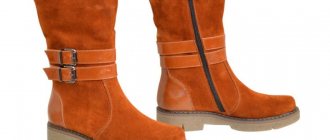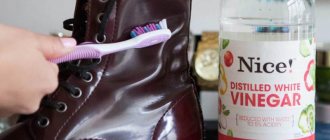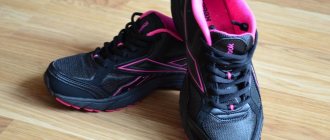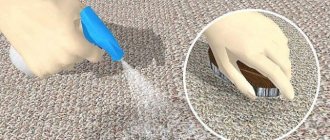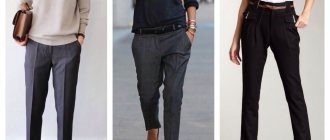Often the joy of purchasing new shoes or boots gives way to disappointment - hard edges rub calluses on the heels, the toe puts a lot of pressure on the toes, the narrow last, like a vice, squeezes the foot. Don’t get upset and rush to the store to buy a new pair, because there are many ways to prevent new shoes from chafing. To stretch the last and soften the material, improvised means and professional sprays are used, and to protect the skin of the feet from rubbing, special stickers, anti-slip insoles and inlays are used.
Why do shoes rub?
Understanding the root cause is useful because it helps to avoid a repetition of the unpleasant plot in the future. The main reasons for the appearance of chafing:
rigidity of shoe parts;- characteristics of the material from which the pair is sewn (poor stretch, rough, hard);
- small shoe size;
- large shoe size;
- unprepared feet for the transition from boots to shoes;
- incorrectly selected pair for lifting;
- structural features of the leg (protruding bones, unusually shaped heels, flat feet);
- profuse sweating (we are talking about the legs);
- the shoes simply do not fit the design (for example, their sides are too high).
Trouble can also arise due to lack of habit. For example, this happens when you first become acquainted with wicker sandals and flip-flops, in which the connecting strap passes between the big and index toe. The skin simply had not previously felt the characteristic pressure in the indicated area, therefore it was not ready for it and reacted to it as best it could.
Another way to “get” a callus is to engage in rare physical activity, walking all day. The skin of the feet, unprepared for stress, will react extremely sharply to such an out-of-the-ordinary event.
How to prevent problem areas from appearing?
Prevention is the best medicine. The measures taken within its framework affect both feet and shoes. Choose one of the methods presented for the legs and shoes and repeat many times, unless the instructions say otherwise.
Before the start of the season you need...
Feet are more comfortable in boots due to their design features. Boots, shoes and sandals are held in place by applying pressure to certain points. The places that apply pressure - the heel, toe, vamp, strap - are the ones that rub most often. Therefore, be sure to pay due attention to the areas of the body that come into contact with these parts of the shoe.
To prepare your feet for the summer-spring season after “resting” in boots, treat yourself to baths with the following components (choose one):
- chamomile (hold for 20 minutes);
- calendula (hold for 30 minutes);
- oatmeal (0.5 liters per basin of water, you can add a spoonful of pine needles);
- heated milk (liter per 3 liters of water, keep for half an hour);
- aroma oils (2 drops each of tea tree and bergamot, 3 drops of lavender, 10–15 ml of bath foam, 3 liters of water, a little cream; hold for 15–20 minutes).
After the bath, you need to treat the foot : remove roughness (do not overdo it, because wounds will easily appear at the site of damage in the future), tidy up your nails, do a massage using sunflower oil or a specialized cream. Upon completion of the manipulations, raise your legs up (put them on some elevation) and stay in this position for some time.
These activities should not be one-time in nature . You need to act systematically and for at least a week, and preferably 2-3 weeks. If you do this, you will not only prepare your legs for the season, but you will also be able to reduce the severity of swelling and also tidy up your lymphatic system.
What remedies help?
Panthenol, baby cream, Bepanten, which are sold in pharmacies, are excellent solutions for softening and preparing feet for the season of shoes and sandals . You can use them for a while or use them shortly before trying on new shoes. Shortly in this context is the time required for complete absorption.
Don't forget about the adhesive plaster . Do not ignore its preventive properties and protective functions: apply it before putting on problematic shoes or sneakers, and not after damage appears.
Universal methods
There are ways to stretch shoes that are suitable for all models, styles and materials. Gradual stretching will help maintain the integrity of the material. The appearance will not be affected if you use specialized products.
Professional products
In addition to traditional methods, you can use special sprays and foams to stretch all types of material. Professional teams will effectively cope with the task in a short time.
Mechanical devices
Special pads with a screw mechanism are available in several options. There are compact sliding models for stretching in width. Multifunctional shoe stretchers in all directions will help to widen, lengthen and increase the instep.
Use the information in this article and helpful tips to make your shoes more comfortable. Take safety precautions and test chemical formulations before applying them. Simple folk remedies will help reduce the cost of purchasing professional products and the services of a shoemaker.
What can you do with shoes?
Recommendations for folk and home use:
- Vodka or alcohol, rubbing. Wet the swab and wipe the inside of the shoe. Pay close attention to problem areas - the heel, vamp. At the end of the procedure, put on a pair and walk in it without taking it off for 1-2 hours. If necessary, repeat the manipulation the next day, but do not get carried away too much. Alcohol may discolor the material. Therefore, before using the product for the first time, perform a test on an inconspicuous part of the shoe.
- Castor oil. They have a softening effect and have a positive effect on both shoes and skin. To achieve the goal, you just need to wipe the inside of your sneakers or shoes several times.
- Vodka or alcohol, kneading. A method similar to the previous option, the only difference is that after processing the shoes or boots will need to be rinsed with your fingers. A solution for those who purchased a pair with very hard walls that cut into the leg.
- Hammer. Wet the gauze, wring it out lightly and spread it over the shoes. Take a hammer in your hands and use it to beat off all the problem areas. After double exposure to the tool and water, they will become softer.
- Newspapers. Wet newspapers and fill the entire inner cavity of the rubbing shoe with it. Leave it like this overnight, take it out in the morning and try it on. The method is good, but you need to remember that letters from newspaper sheets can be imprinted on light skin. In addition, you need to ensure that shoes filled with wet pages do not end up in a draft or near heating devices.
- A bag of water and a refrigerator. Fill a heavy-duty bag with water (not all the way), tie it, and check that the knot or latch is tight. Once you are sure of this, place the bag in the rubbing steam and place them in the freezer. The benefit of the method is based on the expanding effect of water when it hardens. The liquid will freeze and put pressure on the walls, which will expand the internal space of the boots or shoes.
- Sunflower oil. A solution for those whose shoes have become rough after spending the winter in the closet. You need to treat the surface of the pair, and then knead it with your fingers.
- Beer. The method is primarily intended for suede shoes. It is rubbed with an alcoholic drink, after which it is pressed with fingers and worn.
If the material of the product or its finishing does not tolerate direct contact with liquids at all, then give it a “bath” . Wrap the new pair box on all sides with a damp towel and leave it like that overnight. By morning, the cardboard will become unusable, but the shoes will become less rough and fit better on your feet.
Special means
Folk wisdom is good, but the scientific approach is distinguished by its quick effect and safety. In a shoe store you can find:
sprays that help shoes wear out;- protective strips for legs;
- anti-slip insoles and inserts.
The first remedy is suitable for those who bought narrow shoes in the hope of breaking them in. You can enhance the effect of the product by preheating the inner cavity of the shoe (heat it with a hairdryer and then spray it with spray). After application, immediately put on your shoes and walk around the house in them a little.
Important! The spray is not designed for single use, that is, the effect of using the spray becomes noticeable 2-4 times.
Protective strips are applied to areas that may chafe . Usually this is the heel, the outer side of the thumb and little finger, the top line of the vamp. When choosing where to apply the stripes, take into account your personal experience (remember where you usually get calluses) and the design of a particular pair (woven sandals often rub on the front, and flip-flops rub between the big and index toes).
Important! To speed up the break-in process, wear a new pair over thick socks. They will allow you to quickly soften the walls and increase the internal space of the shoe, but the goal will be achieved at the expense of discomfort and, possibly, even chafing.
Anti-slip insoles, in turn, will help those who, in the hope of avoiding calluses and discomfort from wearing high-heeled shoes, purchased shoes or sandals 0.5-1 size too large. You can’t do without them even if your foot sweats a lot, causing it to slip on the insole and get injured on the walls of the shoe.
The pharmacy sells another interesting remedy against calluses - anti-callus pencil . This is a very compact solid preparation for external use. Contains nourishing, softening, and sometimes antiseptic components. It applies easily, leaves no marks even on velvety shoes, and does not smell.
Important! Pencils from the Medifit and Compeed brands have proven themselves to be the best.
Some medications in this group are suitable not only for the prevention of callous formations, but also for their treatment. However, most of them still have a narrow purpose and should not be used on damaged tissue.
Silicone insoles and liners
Silicone insoles with a cooling effect are an effective solution for preventing calluses and corns. Such “gadgets” will protect your skin from excessive friction on the inner surface of your shoes and help maintain the beauty and health of your feet, even if you decide to have a summer romance with spectacular stiletto sandals.
You can find a variety of silicone products on sale:
- Inserts under the toes, under the heel;
- Full insoles;
- Soft self-adhesive strips;
- Heels and short socks.
For example, if the main problem area of the shoes is the hard edge, which literally cuts into the skin and injures it, then it is enough to glue strips of silicone around the perimeter of the cutout, and this will protect your feet from chafing. If you have previously developed soft calluses on the soles, then you should think about purchasing special inserts that completely or partially cover the original insole.
What to do if the shoes have already rubbed?
First you need to disinfect and dry the wound a little . For this purpose, hydrogen peroxide, brilliant green, iodine or furatsilin are used. You can also resort to a weak solution of potassium permanganate (the color should be soft pink, unsaturated). Sometimes chamomile infusion, sea buckthorn oil, and certified calendula leaves are used as a healing and soothing agent (brew for 20 minutes).
Important! Herbs are used in many ways. Some people wipe the wound with tinctures, others take baths (15 minutes, provided that an allergy to herbal medicine has never manifested itself before).
If the callus has not burst, but is very swollen, then it is better to pierce it. The puncture is performed with a carefully processed needle (it is better to take a new one, enclosed in a sterile syringe package). After damage to the formation, the exudate should be removed from it, and then it will be possible to neutralize and dry the wound.
It is not recommended to seal the damage immediately after treatment. It is necessary to ensure a flow of air to the burst callus, due to this the recovery period will proceed faster and the likelihood that the rubbed area will begin to get wet during healing will be reduced.
Only after 2–3 hours from the moment of disinfection can the wound be treated with a caring healing agent. Recommended ointments and sprays for use:
- Panthenol, D-panthenol, Panthenol-Teva (available in the form of ointment and spray);
- Rescuer (balm and ointment);
- Levomekol (ointment);
- Solcoseryl (a whole series of drugs in the form of a spray, disinfectant liquid and ointment);
- Bepanten (gel and ointment);
- Methirulating ointment.
Important! Panthenol and Bepanten can be safely used on children's skin.
Some ointments leave the wound open, while others require a bandage or plaster. The product itself is used spot-on; there is no need to rub it into the rubbed area.
If trouble with new or uncomfortable shoes catches you on the road, then special napkins (buy them in advance at the pharmacy) or anti-corn medication (for example, Lapis Pencil) will come to the rescue . As a last resort, you can resort to plantain and boiled egg. Traditional medicine says that the first one is kept on the foot until signs of drying out of the leaf appear, and with the help of the second one makes medicinal applications: separate the film from the wall of the shell, apply it over the callus, and fix it with a band-aid. The “bandage” is removed after 4–6 hours. After removing it, the rubbed area will need to be disinfected.
Callus on the heel: types and ways to get rid of it
Calluses are thickening of the stratum corneum of the skin. At this site, a layer of dead cells forms, which overlap each other and form a callus. Calluses occur in areas of constant friction or pressure on the skin from shoes. There are two types of callus on the foot:
Wet callus
pixabay
It is a bubble filled with a clear liquid. If the heel of the shoe presses on the skin, swelling and redness occur at the site of friction. The top layer of epithelium peels off and fills with fluid. All this is accompanied by pain and inability to walk. A couple of hours spent in new shoes is enough, and now this nasty, painful blister appears on the heel. If you do nothing, this callus will go away on its own. But there is a danger that when the blister breaks, an infection can get into the wound. For the same reason, you should not pierce the bladder yourself.
With a small callus, the liquid will resolve on its own. This usually takes three to five days. For now, the callus needs to be sealed with a bactericidal plaster - this will reduce pain when moving and prevent infection.
For speedy healing, you can use a compress with aloe: rinse a piece of the plant leaf with warm water and chop it. Apply the prepared mixture onto the bubble and cover with a clean napkin. Also, during the healing period, it is advisable to limit mobility as much as possible.
If a bottle of liquid has opened, do the following:
- Treat the wound with hydrogen peroxide.
- At night, apply levomekol ointment to it, cover it with a sterile napkin and tie it up. Antibacterial ointment will disinfect the wound and promote rapid healing. In the morning, the bandage should be removed and, if possible, the injured surface should be left in the open air.
- If you need to go somewhere, cover the wound with a bactericidal bandage.
Dry callus
pixabay
These calluses look like a lump on the skin that protrudes above its surface. Most often, such a callus forms on the heel, foot and toes from constant friction with shoes. It is easier to remove a dry callus yourself than a water callus. In addition, with dry calluses there is no risk of infection.
First, the seal on the skin needs to be softened. There are several ways:
- Make a special bath: dissolve soda and laundry soap in warm water. It is enough to hold your foot in such a bath for 15 - 20 minutes, then carefully remove the stratum corneum with pumice.
- Instead of soap and soda, you can use a compress of grated raw potatoes and aloe. The pulp is applied to the callus for 10 - 12 hours, after which it is also treated with pumice. Most likely you will have to repeat several of these procedures. It is important to act carefully so as not to damage healthy tissue.
- Lemon juice softens the skin well due to its acid content. Apply it two to three times a day to the callus until completely dry.
- After each such treatment, the skin needs to be moisturized. For softening and healing, use salicylic ointment about three times a day.
- And finally, the easiest and safest way to remove dry calluses is to visit a pedicure salon. The specialist will carefully remove the stratum corneum with a special device and give advice on skin care.
How to distribute it?
You can often hear recommendations to “take a new pair by storm”, that is, wear it at home on the weekend and not take it off all day, or at least the evening. In fact, prolonged wear will not lead to anything good. You need to break in your shoes gradually, 2 hours at a time over several days . It is also very important to properly prepare for the first time putting it on.
To ensure everything goes smoothly, apply adhesive tape to all sensitive areas of the skin. It’s easy to identify them; you just need to remember the places where calluses most often appear. Typically this is the heel, the area above it (the point where the heel ends), the big toe and the little toe. It will be useful to take into account the design features of a particular pair. If, for example, she walks with her nose open, then tape the tips of her fingers.
When using shoes for the first time, put something nylon on your feet - socks or tights. The material has a tightening property, “picks up” the foot, and it feels easier in the very limited space of the shoes.
Important! As you wear them out, you can discard the tights, but this will not happen on the first or even the second day of wear.
After walking around in your shoes for a while, take them off until tomorrow and carefully examine your feet. Their condition will tell you where tomorrow you will need to stick the adhesive plaster. If, after several fittings, things still haven’t moved forward, then lubricate all problem areas with soap or a candle (do this for several days in a row). In addition to home remedies for stretching shoes, there are also store-bought ones (look for them in shoe departments).
Don’t despair if all attempts at spreading have ended in failure and even the use of additional means did not help. Take the problem pair, take it to a repair shop and ask a specialist to widen the shoes that are too narrow.
Hairdryer treatment
What to process? Buy special products intended only for varnishing. Others won't work. Every fashionista has a hair dryer at hand; use a hair dryer, but be careful, patent leather pumps can crack.
Action steps:
- Direct a hot stream of air into the product, avoiding contact with the surface;
- When the shoe warms up, lubricate the top with greasy cream or Vaseline;
- Put on socks, put on shoes, wear them for 2 hours;
- When the shoes become loose, wipe off the remaining cream with a soft cloth.
You can use boiling water:
- pour boiling water inside the product;
- hold for 2 minutes;
- Drain the liquid and wear the shoes.
Be extremely careful with boiling water ; if it gets on patent leather, it will damage the product irrevocably.
How to choose the right shoes to avoid blisters later?
Recommendations to help avoid trouble with calluses:
Walk in shoe shoes in the afternoon. At this time of day, the typical changes in your legs are already making themselves felt, be it swelling or pain.- Adequately assess your capabilities and health. If your feet swell and become very tired in the evening, then you should not choose narrowed models with maximum heels. If the instep is high, then the shoes, which end at the top almost immediately after the toes, will rub.
- Buy shoes that fit.
- Always try on shoes before purchasing . Don’t just put your foot in the shoe, but also trample in it, walk around and try to take it off and put it on several times. Sports sneakers and sneakers are additionally checked for the flexibility of the sole (stand on the toe, and then transfer the weight to the heel, then to the left, and then to the right edge).
- When trying on, listen to your feelings . Don’t believe that a particular pair will stretch significantly, but you yourself will put on nylon tights and due to them, the size of your legs will mystically decrease by 1-1.5.
- Genuine leather and suede stretch, but there is no point in relying on this quality. In the best case, the pair will fit a little more loosely on the leg, its width will increase slightly, but the length will remain the same. The maximum you can gain is 0.5 sizes. At the same time, artificial materials wear out even worse . Instead, they just tear.
- Don't buy a pair to grow into . A foot that is poorly secured and sliding on the insole will chafe almost faster than a foot that is tightly squeezed by the walls of the shoe. If you couldn’t resist and purchased excessively large shoes, you can get around the problem using double-sided tape. They literally glue the foot to the shoes or sandals.
Shoe defects
Why do you need shoe wax?
New shoes rubbed my feet: first aid!
So, the worst has already happened, your feet are bleeding, and in the middle of the working day you can barely drag your feet, while trying to maintain a firm gait and a sweet expression on your face. The worst thing when a dropsy breaks through is that particles of dust and other contaminants get into the wound. If you have the opportunity to take a short break or simply no longer have the strength to go and endure how the hard back continues to wear your skin down to the bone, then:
- Sit down and carefully remove your shoes (it is also advisable to remove socks and tights);
- Let your feet breathe a little while you assess the scale of the tragedy, inspect your purse for wet wipes, bandages, adhesive plaster, hand sanitizer;
- If possible, the wound should be washed with at least tap water and treated with any alcohol-containing product or antiseptic. It will hurt, but you will have to be patient. The main thing is not to try to tear off the skin that has come off in places where the dropsy breaks out;
- Apply the patch and sit for at least another 10-15 minutes. If you don’t have a patch in your purse, you can put a kind of barrier of wet wipes between the inner surface of the shoe and the skin, this will allow you to somehow get to the nearest pharmacy.
Treating chafing and calluses is a rather lengthy and painful process. Therefore, it is worth at least trying to prevent their occurrence. Do you think that wearing the same comfortable pair all the time is boring? Then we recommend that before going out for the first time in new shoes or sandals, you give them a “test by combat” (walking, jumping, steps) at home, and if you are not satisfied with the result, you need to break the pair in at home in advance. Moreover, now you know more than one way to do this.
